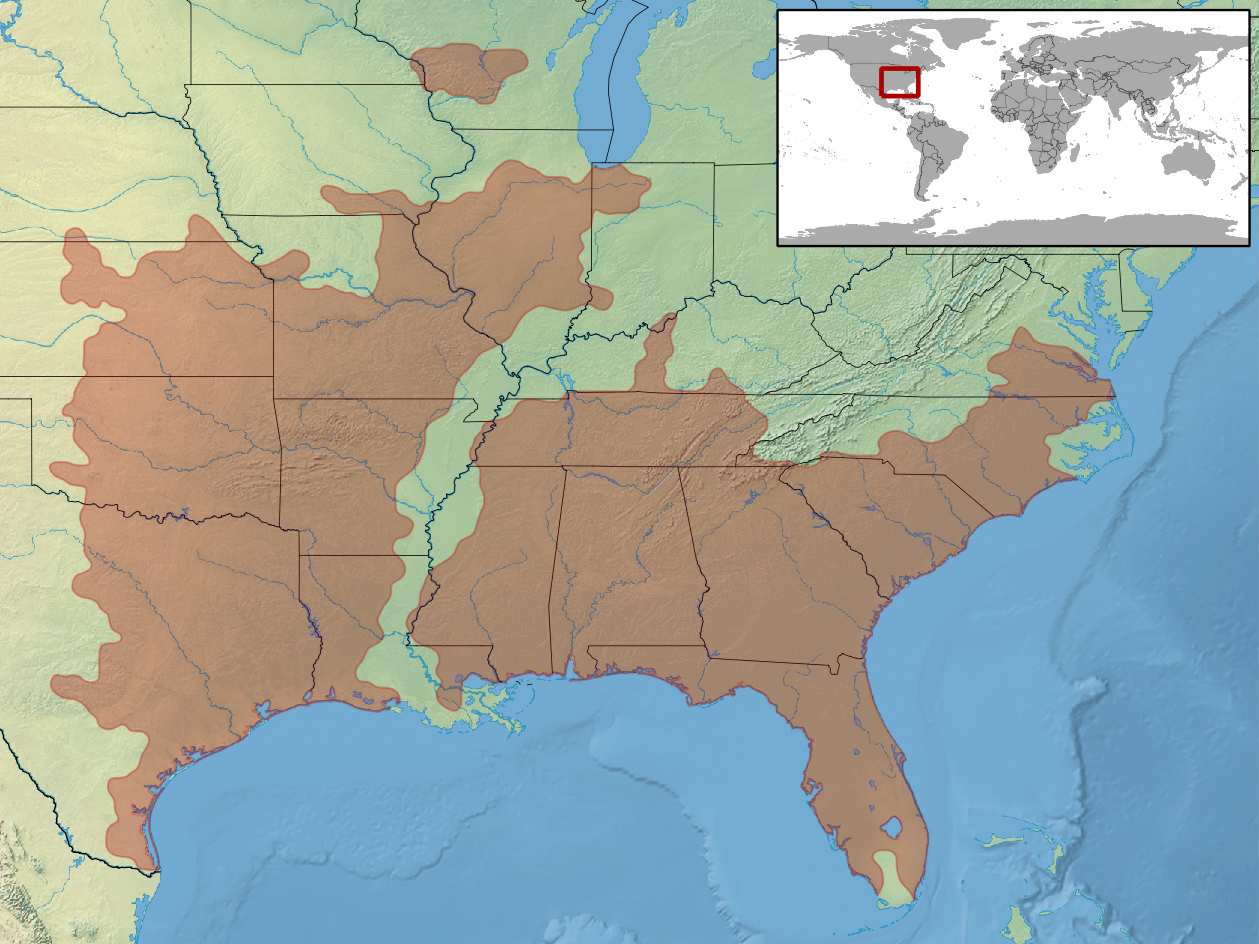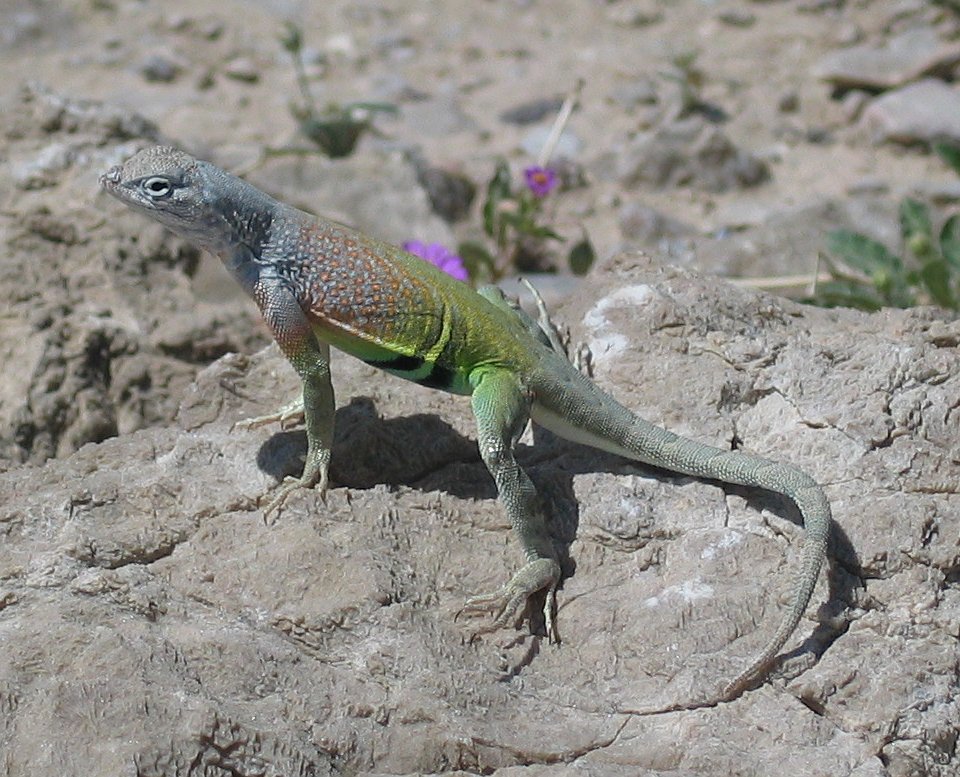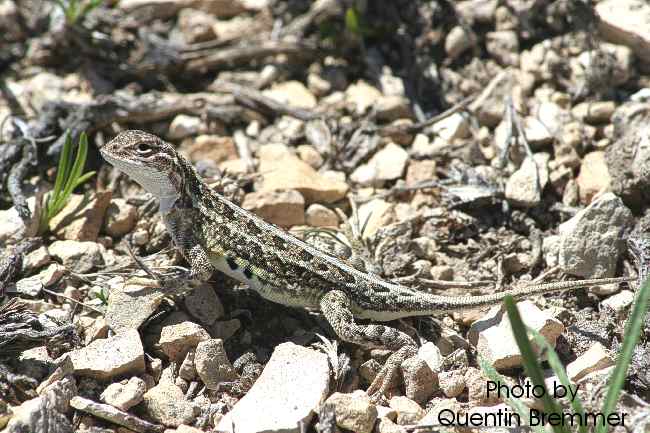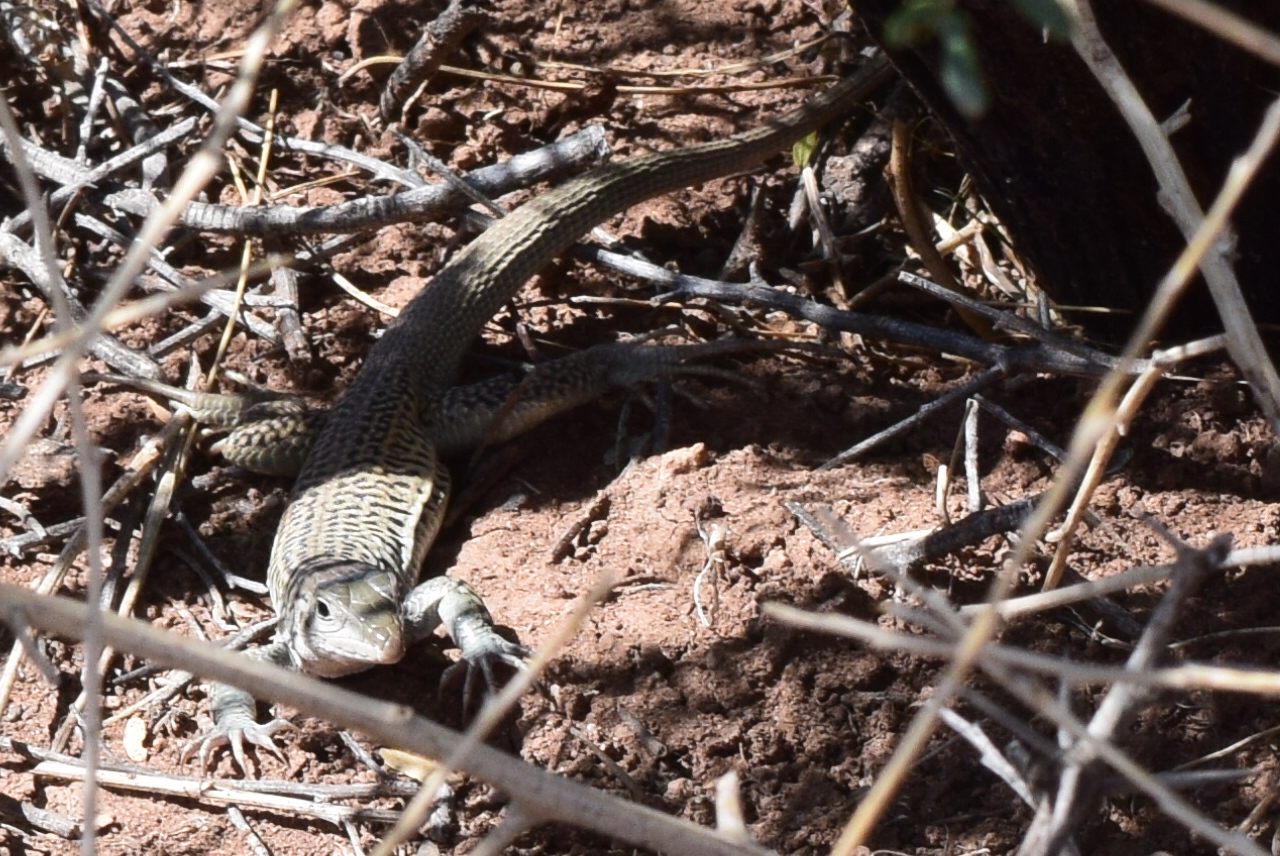There are 18 lizards that are native to Oklahoma. Maybe you’ve seen one or two in your yard. Maybe you’ve come across them when visiting the area or on a walk. Find out more about the lizards in Oklahoma below.
Are there poisonous lizards in Oklahoma?
None of the lizards in Oklahoma are poisonous to humans or dogs. Only the Gila Monster, which is not found in this location is considered poisonous.
Note that lizards can cause illness, so it’s advisable to wash your hands thoroughly after touching or handling a lizard.
Lizards That Can Be Found in Oklahoma
List of 18 lizards can be found in Oklahoma:
- Green anole
- Slender glass lizard
- Eastern collared lizard
- Prairie lizard
- Greater earless lizard
- Texas horn lizard
- Western earless lizard
- Little brown skink
- Coal skink
- Common five-lined skink
- Broadhead skink
- Great plains skink
- Prairie skink
- Mediterranean house gecko
- Common spotted whiptail
- Six-lined racerunner
- Prairie racerunner
- Gray-checkered whiptail
1. Green Anole

Scientific name: Anolis carolinensis.
Common name: Green anole, Carolina anole, Carolina green anole, American anole, American green anole, North American green anole, red-throated anole, American chameleon.
The green anole is a small to medium lizard with a very slender body. They have a long and pointed head with males being larger than the female.
Males also have a dewlap that is three times bigger than the females, it’s also bright red, where the female’s dewlap will be lighter. Females also have a white stripe that runs down their back.
Males can grow up to 8 inches (20cm), while its body makes up approximately 80% of the body.
The green anole’s color varies from green to brown. Males tend to be territorial and will fight with another male to defend their territory.
Bobbing of the head and initiating the dorsal ridge with an extended dewlap are signs of aggression used to chase rivals away.
Related – 8 popular pet anole lizards
2. Slender Glass Lizard

Scientific name: Ophisaurus attenuatus.
Common name: Slender glass lizard.
The slender glass lizard grows up to 107cm or 42 inches. These are very slender and long lizards with no legs. In fact, they look more like a snake than a lizard.
Similar to the eastern glass lizard, the slender glass lizard is yellow to brown in color with dark markings found below the lateral grooves. Many of these lizards will have a dark stripe which can be seen running down the center of their back.

These lizards appreciate a dry habitat, often found in sandhills and old fields. They are active during the day, hiding beneath debris and boards.
They break off a section of their tail in defense if caught by a predator. The tail will continue to wriggle while the lizard escapes. The piece of the tail will regrow over time.
3. Eastern Collared Lizard

Scientific name: Crotaphytus collaris.
Common name: common collared lizard, eastern collared lizard, Oklahoma collared lizard, yellow-headed collared lizard, collared lizard.
The eastern collared lizard is the Oklahoma state lizard and is distinguished by its large size and large head.
It is bright in color with a tail that is double the length of the body complete with a black collar around the neck.
The collar looks like an irregular back line which can be found just behind the head, this is then followed by a wider and darker line, which runs from the back to the top of the front limbs.
The background color in adult males is green with some orange and yellow markings.
Females tend to be gray but may have orange patterns during mating season.
These lizards are active from mid-March to September. They mate from mid-April to June.
4. Prairie Lizard

Scientific name: Sceloporus Undulatus.
Common name: Eastern fence lizard, prairie lizard, fence swift, gray lizard, northern fence lizard, pine lizard.
The prairie lizard is distinguished from other Oklahoma lizards by its overlapping and pointed scales. Their tails are longer than the body with a variable of color and pattern.
Colors tend to be brown, gray, and white with lines that may or may not be present. They often have a gray stripe which runs along the mid line of the body.
Males are easily identified by their blue green patches which are surrounded by black and can be found on the ventral body surface.
These lizards are active throughout the year if temperatures remain high enough. Though you will see them mostly from March to October.
Males are very territorial during breeding season and can be aggressive when interacting with other males.
These lizards are over three inches from snout to vent and are able to break their tails off to distract predators, enabling the lizard to escape to safety.
5. Greater Earless Lizard

Scientific name: Cophosaurus texanus.
Common name: Greater earless lizard.
The greater earless lizard is approximately 7 inches in length from the nose to the tip of the tail with males being larger than females.
They have a streamlined shape with small scales and a wedge-shaped head with no ear openings and large eyes.
These lizards are mostly brown or gray in color, with yellow to orange rows which can be seen on the hind-quarters. They have dark bands across the top of the legs with two dark black stripes on the back of each thigh.
When a female is pregnant, she will have a pink throat and flank.
These lizards prefer living in the open desert areas in the Rocky Mountain foothills. They are often seen on sandy and gravel roads.
They emerge from hibernation in the Spring and are busy and energetic during the daytime.
They curl their long tails over their backs when they run from rock to rock. They also raise their tail when approached by predators.
6. Texas Horn Lizard

Scientific name: Phrynosoma cornutum.
Common name: Texas horned lizard.
The Texas horn lizard is different from other lizards found in Oklahoma by their short, squat body and two large horns on the back of their heads with two small horns on their side.
Their tail is short and pointed with a thin white line that can be found on their backs from the neck to the end of the tail. The scales are not bone but are there to protect the lizard against predators. These lizards can vary from brown to gray to red with a cream belly.
They are active from April to September in Oklahoma before going into hibernation for the winter months. They can be seen in open areas where there is sand.
They tend to rely on their camouflage rather than their speed when escaping predators. If grabbed, it squirts a stream of blood from their eye cavity towards the predator. The blood has a bad taste and repels the predator.
Female Texas horn lizards are approximately five inches in length from snout to vent with males being on the smaller side, usually growing up to 3.7 inches.
7. Western Earless Lizard

Scientific name: Holbrookia maculata.
Common name: Western earless lizard, lesser earless lizard.
This is a medium-sized lizard that can grow up to 5 inches (13 centimeters) from snout to the end of the tail.
They are light gray to gray brown in color with dark blotches on the back and pale stripes down their sides. They have a white underside and they have a relatively short tail when you compare them to other Oklahoma lizards.
The western earless lizards is a very active predator enjoying a mix of insects and spiders.
They seek shelter amongst vegetation during the heat of the day. They prefer temperatures of at least 70 degrees Fahrenheit. They are not as active when temperatures cool.
These are territorial lizards with males bobbing their heads to attract females. They reach sexual maturity at one year.
8. Little Brown Skink

Scientific name: Scincella lateralis.
Common name: Little brown skink, ground skink.
The little brown skink is a small skink with slender limbs that only reaches approximately 5.7 inches or 14cm in total length.
They tend to be tan to golden brown in color with narrow brown stripes down their sides.
Juveniles are bronze with black flecks, which are more noticeable at the tail. They have dark stripes which are distinct on the body, head, and tail.

9. Coal Skink

Scientific name: Plestiodon anthracinus.
Common name: Coal skink.
The coal skink can brown up to 7 inches or 18 centimeters and is considered medium-sized lizards with short legs and streamlined bodies.
Their body is brown to gray in color with four yellow to white stripes, two on either side. They do not have a stripe down the center of their back, which distinguishes them from other skink species.
These skinks can be found in a host of habitats, often along stream edges, under rocks, logs, and other hiding spaces where they feel securer and safe.
They will break their tail when caught in order to distract the predator and allowing them to escape.
10. Common Five Lined Skink

Scientific name: Plestiodon fasciatus.
Common name: American five-lined skink, common five-lined skink.
These skinks grow up to 21 centimeters or 8.5 inches in length.
They are large lizards with a streamlined body and short legs. They are brown, black, or gray in color with five yellow to white stripes, two down each side of the body and one down the back.
Juveniles often have bright blue tails, which fade as they age. Males have red to orange color on their heads and often lose their stripes.

These skinks enjoy moist habitats, often found in wooded river margins and forests. You may find them in trees or on the ground, they are usually tree dwelling, though they may be found under a log. They run for the nearest tree or log.
They are fast and not easy to capture, they also break off their tail as a defense mechanism to help them escape predators.
11. Broadhead Skink

Scientific name: Plestiodon laticeps.
Common name: Broad-headed skink, broadhead skink.
The broadhead skink measures up to 13 inches (33cm) in length and are the largest of the skinks you will find in the southeast. They have streamlined bodies with short legs.
The body is usually black, brown or gray in color with five white to yellow strips, two on either side of the body and one down the back.
Adults usually fade as they age, becoming brown or gray, though males sometimes develop large orange heads with powerful jaws.

These skinks live in trees and on the ground, though the larger males tend to spend more time in the trees than on the ground.
They sun on exposed branches, while the young are often found hiding under debris and fallen trees on the ground.
They are fast and difficult to catch. Should you catch one, it will break its tail, distracting the predator while it escapes.
12. Great Plains Skink

Scientific name: Plestiodon obsoletus.
Common name: Great plains skink.
The great plains skink is different from other lizards in Oklahoma with its glass-like scales, which are light in color, usually a tan or brown with black to dark brown borders.
They have poorly defined stripes which can be found on the dorsal and mid-dorsal surfaces.
Males tend to have a bigger head than females. During the breeding season, males have orange coloration on their head, neck, and body.
Juveniles are black in color with brilliant blue tails, orange areas on the head, and a white upper jaw.

These skinks tend to be very active from mid-March through to the start of October.
They are large skinks in size and when adults, they will grow to at least five and a half inches from snout to vent. The tail tends to be approximately ten percent longer than the lizard’s body.
13. Prairie Skink

Scientific name: Plestiodon septentrionalis.
Common name: Prairie skink.
The prairie skink is brown or tan in color with darker coloration on the sides. They can be distinguished by the lines that run down their bodies. They grow up to nine inches (22cm) in length and have short legs.
Their tails are gray-blue in color. When juveniles their tails are bright blue.
Males have a red head and throat during the mating season.
The prairie skink has a brown or tan back, with darker sides, and is easily distinguished by the lines running down its body. It is 13 to 22 centimeters (five to nine inches) in length and has short legs. Adults have blue-gray tails, while juveniles have bright blue ones.
During the breeding season, which takes place in spring, males’ heads and throats turn reddish-orange.
14. Mediterranean House Gecko

Scientific name: Hemidactylus Turcicus.
Common name: Mediterranean house gecko.
Mediterranean house geckos are very common around the world and were first found in the United States in 1915, since then they have become an invasive species.
They are small in size and are pink, brown or gray in color with dark patterns or spots. They are very similar to the common gecko, but the mediterranean house gecko has a translucent belly and bumpy skin.
These geckos are hardy and very adaptable, which is what makes them very popular pets.
15. Common Spotted Whiptail

Scientific name: Aspidoscelis gularis.
Common name: Common spotted whiptail, Texas spotted whiptail.
The common spotted whiptail can grow up to eleven inches (28 cm) in length, this includes the tail.
They are brown or green/brown in color with seven gray or white strips running the full length of the body, stopping at the tail. They have light-colored spots along their sides.
Males have red throats and blue bellies; females have pink throats.
The tail is longer than the body and is peach or tan in color.
These lizards are most active during the day and can be found in a range of habitats where they prey on insects.
You can find them in canyons, semi-arid areas, and grasslands. They are never far from a permanent water source.
16. Six-lined Racerunner

Scientific name: Aspidoscelis sexlineatus.
Common name: Six-lined racerunner.
Six-lined racerunners have very slender bodies and pointed noses.
Their tails are 70% of the total body length with adults growing up to 26cm. Males tend to be bigger than the female. They are brown, olive, or back in color with six yellow to green stripes that span from the neck to the tail.
Males are larger than females. These are not shiny lizards but look more velvet in appearance. Males tend to have bright blue throats during mating seasons.
Juveniles are around 3cm at birth and have bright green stripes and blue tails.
These daytime lizards are solitary and the most active, largest, and experienced lizards in the population will dominate those around them.
They are fast and will move across their territory with ease. They are active in the morning and spend their afternoons soaking up the sun.
17. Prairie Racerunner

Scientific name: Cnemidophorus sexlineatus viridis.
Common name: Prairie racerunnner.
The prairie racerunnner has seven light-colored stripes with a dark brown or tan body color.
Males have a lot of bright green in their color with blue tinted-bellies and chins. Females and juveniles are not as bright and will have a tan belly with a tan chin. Juveniles tend to have a blue tail.
Prairie racerunners can be found in a host of areas from old rock quarries to railroad.
Their defense is speed and it will be almost impossible to catch them on a warm day. If restrained, they may attempt to bite.
18. Gray Checkered Whiptail

Scientific name: Aspidoscelis dixoni.
Common name: Gray checkered whiptail.
This whiptail is a lizard that is approximately 4 inches in length.
Their base coloration and patterns vary with brown and black markings, stripes or checks on white or yellow. They have a white belly with dark flecks near the throat with slender bodies and a long tail.
They are daytime lizards that prey on insects.
These are fast-moving lizards that will head for cover when approached. You can find them in canyons, hills, semi-arid and rocky habitats.
Further Reading: